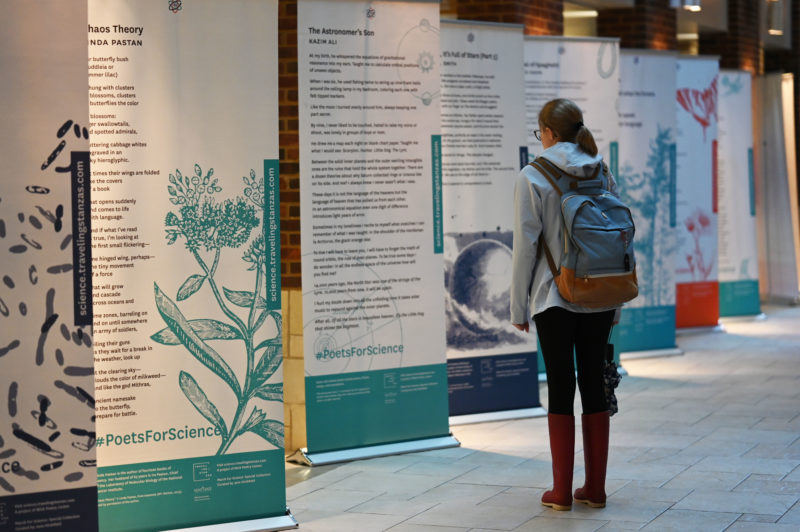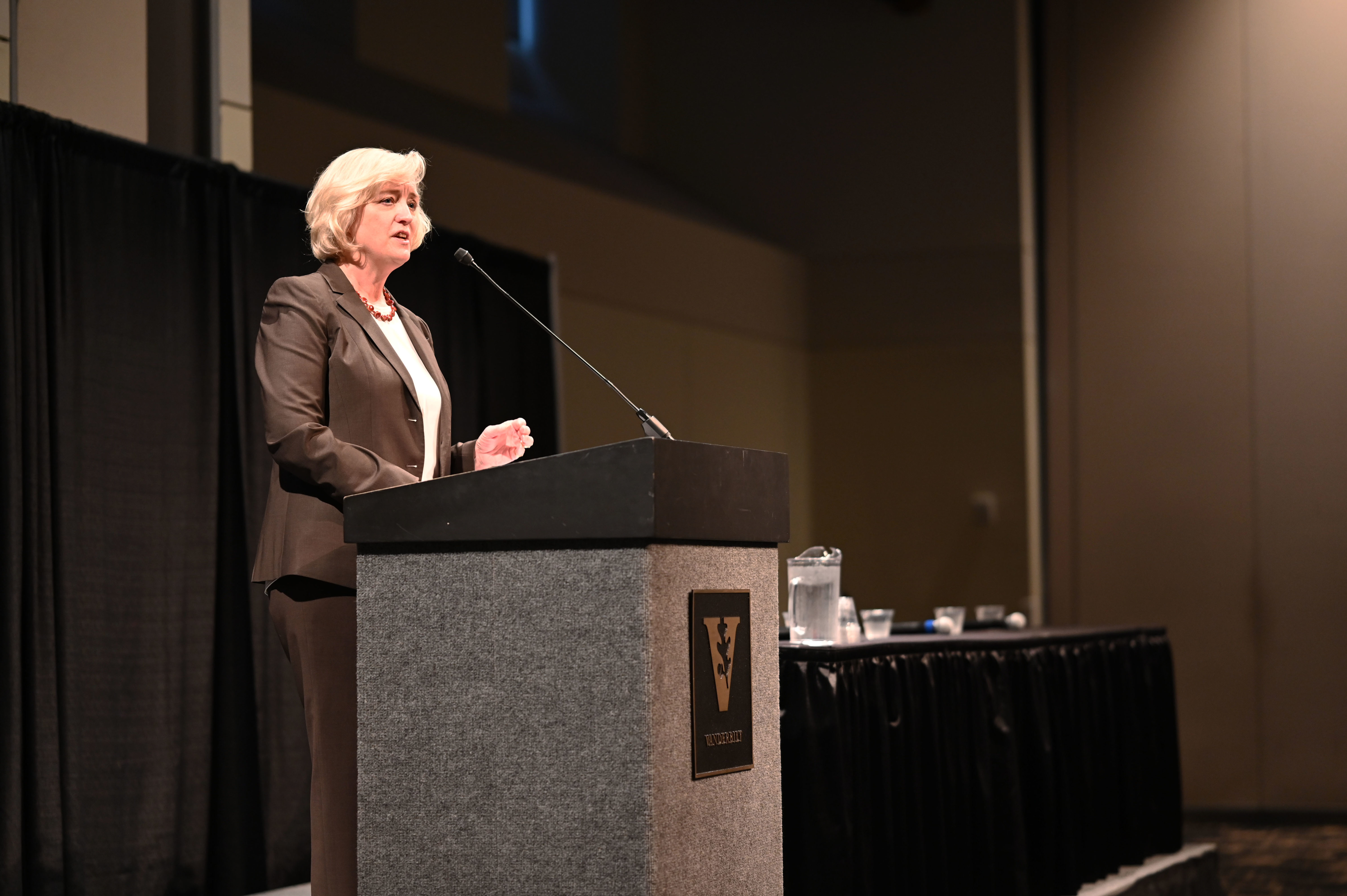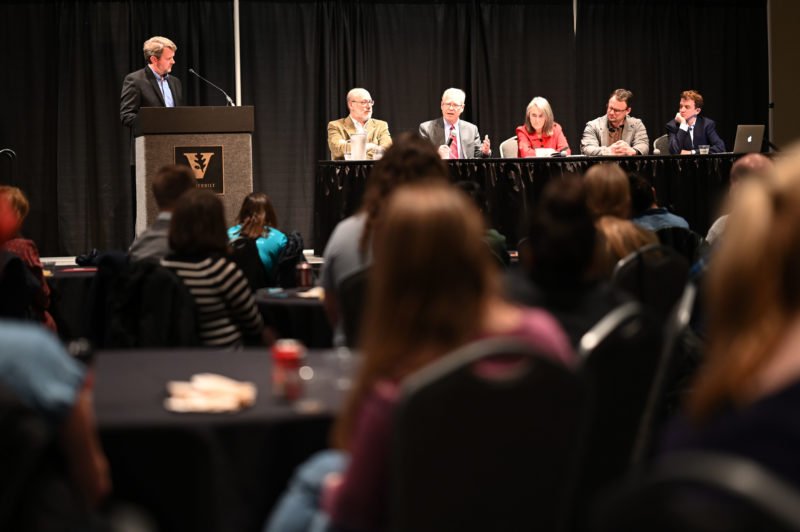Poetry Exhibit, Town Hall Promote Interdisciplinary Collaboration Between Sciences and Humanities
On February 3, an unusual sight greeted visitors to Buttrick Hall. Tall, brightly colored banners lined the Buttrick lobby. Each banner bore a large graphic and a poem. As students, faculty, and staff made their way past the banners, they noticed something unusual: every poem in the collection was about science.

The banners were part of a special exhibit: “Traveling Stanzas: Poets for Science,” operated by the Wick Poetry Center at Kent State University. With verses curated by American poet Jane Hirshfield, the exhibit travels the country to encourage and highlight collaboration between the humanities and the sciences. It includes an interactive element in the form of a digital toolkit, which visitors can use to create their own “erasure” poetry by blacking out words from foundational scientific texts.
The exhibit came to Vanderbilt as part of a larger focus on interdisciplinary collaboration. In addition to poetry displays in Buttrick Hall and the Stevenson Science and Engineering Library, the week included the creation of a community poem, a reception, and a town hall titled “Branches from the Same Tree: Integration of the Humanities and Arts with Science, Engineering and Medicine in Higher Education.”
Interim Chancellor and Provost Susan Wente, who is also an accomplished cell biologist, opened the town hall by referencing recently released photos of the sun’s surface. She said the enthusiastic public response to the visually stunning and unique photos proves how art and storytelling can help scientists better engage the public and increase the impact of research partnerships.

“By collaborating together, whether as poets and engineers, philosophers and chemists, or economists and musicians: that’s how we’re going to tackle the world’s most complex problems,” Wente said.
Members of the town hall panel echoed Wente’s remarks, with a focus on metaphor and story as key tools for advancing the cause of science. The panel, moderated by David Wright, College of Arts and Science Dean of Graduate Education and Research, was co-hosted by the National Academies of Sciences, Engineering, and Medicine (NASEM). A recent NASEM study of interdisciplinary integration between the sciences and humanities found that such integration produces positive outcomes for college students. Panelists included Austen Applegate, NASEM research associate; Jay Clayton, professor of English and director of the Curb Center for Art, Enterprise and Public Policy; Kate Daniels, professor of English and director of the MFA Program in Creative Writing; Charles Malone, program and outreach manager for the Wick Poetry Center; and David Weintraub, professor of astronomy and director of the Program in Communication of Science and Technology.
Clayton and Weintraub asserted that storytelling is crucial at a time when the public has become increasingly distrustful of scientific evidence. By relying on storytelling, they said, scientists can ignite a hunger for scientific knowledge among both their peers and the general public, so that misinformation gains less of a foothold in popular discourse. Weintraub illustrated the point by comparing Galileo, a household name, to Johannes Kepler, who did equally important work but is less well-known.
“Pretty much everyone has heard about Galileo because he wrote for the general public, and he used pictures [to illustrate his work]. Kepler just had equations,” Weintraub said. “Scientists can’t tell our stories through equations. Nobody would read them. If we’re not good at using the tools of the humanities, we can’t tell our stories.”

Speaking from her own experience as a poet, Kate Daniels pointed out that the relationship between disciplines also works in the opposite direction: close, scientific-style observation of the world can help humanistic writers produce richer work. Structural differences and physical separation, however, can throw up obstacles that impede scientists and humanists from learning each others’ methods or collaborating on projects.
“Scientists on campus have a very different life from people in the humanities. They have a lab going, they have to be there all the time in a specific way. [Humanists] get a good book and hole up somewhere. That’s why Vanderbilt has made this huge investment in encouraging students and faculty to get out of their discrete little areas and reach out across campus,” Daniels said.
According to Austen Applegate, this kind of “institutional buy-in” is the top requirement for interdisciplinary collaboration to succeed. Support may come in the form of funding for physical spaces such as the Curb Center, the establishment of interdisciplinary programs such as Communication of Science and Technology, or institutional validation of interdisciplinary work in tenure cases. Vanderbilt, he said, is ideally positioned in these respects.
“Vanderbilt is a very special case. It’s one of the only universities where the administration is really leading the charge, with support from the faculty,” Applegate said. “If you give the faculty a sense that they can own this and take it in any direction, the faculty will be really proud of this work, and it will encourage the students to pursue similar mindsets or schools of thought. I think you’re in a really unique position for success.”
